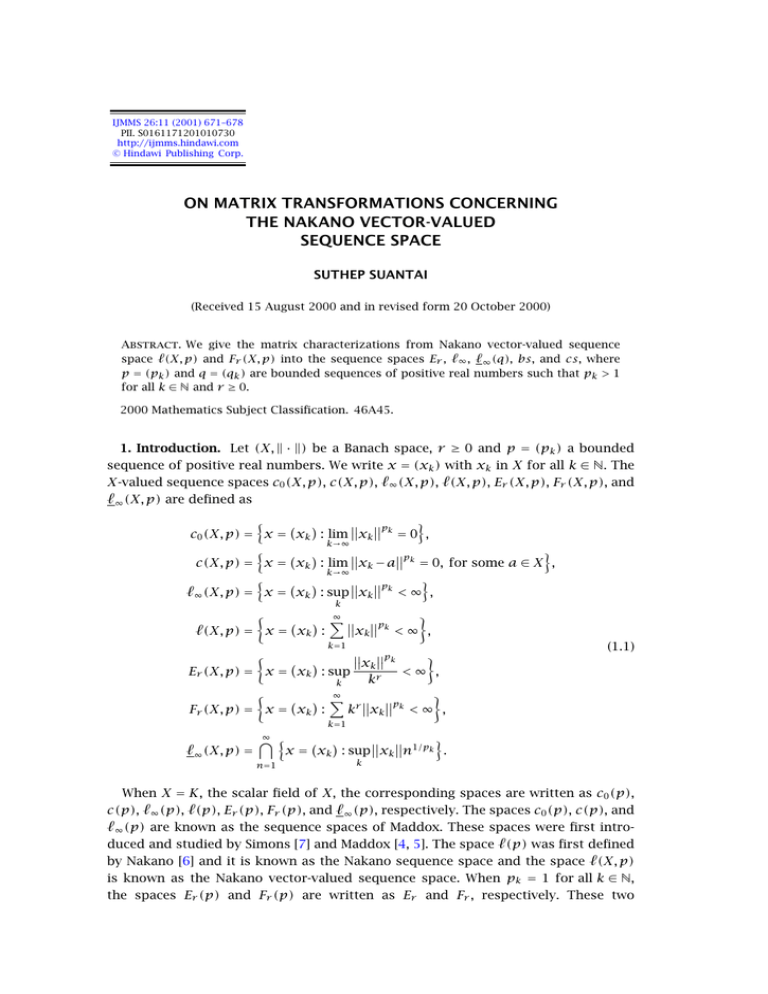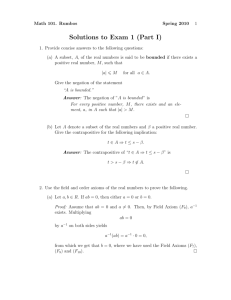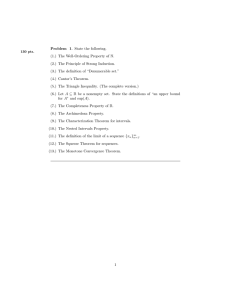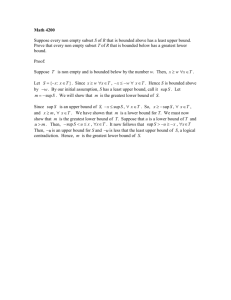ON MATRIX TRANSFORMATIONS CONCERNING THE NAKANO VECTOR-VALUED SEQUENCE SPACE SUTHEP SUANTAI
advertisement

IJMMS 26:11 (2001) 671–678
PII. S0161171201010730
http://ijmms.hindawi.com
© Hindawi Publishing Corp.
ON MATRIX TRANSFORMATIONS CONCERNING
THE NAKANO VECTOR-VALUED
SEQUENCE SPACE
SUTHEP SUANTAI
(Received 15 August 2000 and in revised form 20 October 2000)
Abstract. We give the matrix characterizations from Nakano vector-valued sequence
space (X, p) and Fr (X, p) into the sequence spaces Er , ∞ , ∞ (q), bs, and cs, where
p = (pk ) and q = (qk ) are bounded sequences of positive real numbers such that pk > 1
for all k ∈ N and r ≥ 0.
2000 Mathematics Subject Classification. 46A45.
1. Introduction. Let (X, · ) be a Banach space, r ≥ 0 and p = (pk ) a bounded
sequence of positive real numbers. We write x = (xk ) with xk in X for all k ∈ N. The
X-valued sequence spaces c0 (X, p), c(X, p), ∞ (X, p), (X, p), Er (X, p), Fr (X, p), and
∞ (X, p) are defined as
p
c0 (X, p) = x = xk : lim xk k = 0 ,
k→∞
p
c(X, p) = x = xk : lim xk − a k = 0, for some a ∈ X ,
k→∞
p
∞ (X, p) = x = xk : sup xk k < ∞ ,
k
∞
pk
xk < ∞ ,
(X, p) = x = xk :
k=1
Er (X, p) = x = xk : sup
pk
xk kr
k
<∞ ,
(1.1)
∞
p
kr xk k < ∞ ,
Fr (X, p) = x = xk :
k=1
∞ (X, p) =
∞ x = xk : sup xk n1/pk .
n=1
k
When X = K, the scalar field of X, the corresponding spaces are written as c0 (p),
c(p), ∞ (p), (p), Er (p), Fr (p), and ∞ (p), respectively. The spaces c0 (p), c(p), and
∞ (p) are known as the sequence spaces of Maddox. These spaces were first introduced and studied by Simons [7] and Maddox [4, 5]. The space (p) was first defined
by Nakano [6] and it is known as the Nakano sequence space and the space (X, p)
is known as the Nakano vector-valued sequence space. When pk = 1 for all k ∈ N,
the spaces Er (p) and Fr (p) are written as Er and Fr , respectively. These two
672
SUTHEP SUANTAI
sequence spaces were first introduced by Cooke [1]. The space ∞ (p) was first defined
by Grosse-Erdmann [2] and he has given in [3] characterizations of infinite matrices
mapping between scalar-valued sequence spaces of Maddox. Wu and Liu [10] gave
necessary and sufficient conditions for infinite matrices mapping from c0 (X, p) and
∞ (X, p) into c0 (q) and ∞ (q). Suantai [8] has given characterizations of infinite matrices mapping (X, p) into ∞ and ∞ (q) when pk ≤ 1 for all k ∈ N and he has also
given in [9] characterizations of those infinite matrices mapping from (X, p) into the
sequence space Er when pk ≤ 1 for all k ∈ N.
In this paper, we extend the results of [8, 9] in case pk > 1 for all k ∈ N. Moreover,
we also give the matrix characterizations from (X, p) and Fr (X, p) into the sequence
spaces bs and cs.
2. Notations and definitions. Let (X, · ) be a Banach space, the space of all sequences in X is denoted by W (X), and Φ(X) denotes the space of all finite sequences
in X. When X = K, the scalar field of X, the corresponding spaces are written as w
and Φ.
A sequence space in X is a linear subspace of W (X). Let E be an X-valued sequence
space. For x ∈ E and k ∈ N, xk stands for the kth term of x. For k ∈ N, we denote by
ek the sequence (0, 0, . . . , 0, 1, 0, . . .) with 1 in the kth position and by e the sequence
(1, 1, 1, . . .). For x ∈ X and k ∈ N, let ek (x) be the sequence (0, 0, . . . , 0, x, 0, . . .) with
x in the kth position and let e(x) be the sequence (x, x, x, . . .). We call a sequence
space E normal if (tk xk ) ∈ E for all x = (xk ) ∈ E and tk ∈ K with |tk | = 1 for all
tk ∈ N. A normed sequence space (E, · ) is said to be norm monotone if x = (xk ),
y = (yk ) ∈ E with xk ≤ yk for all k ∈ N we have x ≤ y. For a fixed scalar
sequence µ = (µk ), the sequence space Eµ is defined as
Eµ = x ∈ W (X) : µk xk ∈ E .
(2.1)
Let A = (fkn ) with fkn in X , the topological dual of X. Suppose that E is a space
of X-valued sequences and F a space of scalar-valued sequences. Then A is said to
∞
map E into F , written by A : E → F , if for each x = (xk ) ∈ E, An (x) = k=1 fkn (xk )
converges for each n ∈ N, and the sequence Ax = (An (x)) ∈ F . Let (E, F ) denote the
set of all infinite matrices mapping from E into F .
Suppose that the X-valued sequence space E is endowed with some linear topology
τ. Then E is called a K-space if for each k ∈ N, the kth coordinate mapping pk : E → X,
defined by pk (x) = xk , is continuous on E. If, in addition, (E, τ) is a Fréchet (Banach)
space, then E is called an FK- (BK-) space. Now, suppose that E contains Φ(X). Then E
n
is said to have property AB if the set { k=1 ek (xk ) : n ∈ N} is bounded in E for every
n
x = (xk ) ∈ E. It is said to have property AK if k=1 ek (xk ) → x in E as n → ∞ for every
x = (xk ) ∈ E. It has property AD if Φ(X) is dense in E.
It is known that the Nakano sequence space (X, p) is an FK-space with property AK
∞
under the paranorm g(x) = ( k=1 xk pk )1/M , where M = max{1, supk pk }. If pk > 1
for all k ∈ N, then (X, p) is a BK-space with the Luxemburg norm defined by
∞
xk pk
≤1 .
xk = inf ε > 0 :
(2.2)
ε
k=1
673
ON MATRIX TRANSFORMATIONS CONCERNING . . .
3. Main results. We first give a characterization of an infinite matrix mapping from
(X, p) into Er when pk > 1 for all k ∈ N. To do this, we need the following lemma.
Lemma 3.1. Let E be an X-valued BK-space which is normal and norm monotone and
∞
let A = (fkn ) be an infinite matrix. Then A : E → Er if and only if supn k=1 |fkn (xk )|/nr
< ∞ for every x = (xk ) ∈ E.
Proof. If the condition holds true, it follows that
∞
∞ n
f n xk k=1 fk xk
k
≤ sup
<∞
sup
nr
nr
n
n
k=1
(3.1)
for every x = (xk ) ∈ E, hence A : E → Er .
Conversely, assume that A : E → Er . Since E and Er are BK-spaces, by Zeller’s
theorem, A : E → Er is bounded, so there exists M > 0 such that
∞
n
k=1 fk xk
≤ M.
(3.2)
sup
r
n
n∈N
(xk )≤1
Let x = (xk ) ∈ E be such that x = 1. For each n ∈ N, we can choose a scalar sequence
(tk ) with |tk | = 1 and fkn (tk xk ) = |fkn (xk )| for all k ∈ N. Since E is normal and norm
monotone, we have (tk xk ) ∈ E and (tk xk ) ≤ 1. It follows from (3.2) that
∞
∞ n
f n xk k=1 fk tk xk
k
=
≤ M,
(3.3)
r
r
n
n
k=1
which implies
∞ f n xk k
sup
≤ M.
nr
n∈N k=1
It follows from (3.4) that for every x = (xk ) ∈ E,
∞ f n xk k
≤ Mx.
sup
nr
n∈N k=1
(3.4)
(3.5)
This completes the proof.
Theorem 3.2. Let p = (pk ) be a bounded sequence of positive real numbers with
pk > 1 for all k ∈ N and 1/pk + 1/qk = 1 for all k ∈ N, and let r ≥ 0. For an infinite
matrix A = (fkn ), A ∈ ((X, p), Er ) if and only if there is m0 ∈ N such that
sup
n
∞
n qk −r q
f n k m−qk < ∞.
0
k
(3.6)
k=1
Proof. Let x = (xk ) ∈ (X, p). By (3.6), there are m0 ∈ N and K > 1 such that
∞
n qk −r q
f n k m−qk < K,
0
k
∀n ∈ N.
(3.7)
k=1
Note that for a, b ≥ 0, we have
ab ≤ apk + bqk .
(3.8)
674
SUTHEP SUANTAI
It follows by (3.7) and (3.8) that for n ∈ N,
∞
∞
n
n
−1
−r n−r f
f
·
m
x
x
=
n
m
k 0 k 0
k=1 k
k=1 k
≤
∞
n−r m0−1 fkn m0 xk k=1
≤
∞
−r qk
n
q
−q m0 k fkn k
+ m0α
k=1
∞
pk
xk (3.9)
k=1
∞
pk
xk ,
≤ K + m0α
where α = sup pk .
k
k=1
∞
Hence sup n−r | k=1 fkn (xk )| < ∞, so that Ax ∈ Er .
For necessity, assume that A ∈ ((X, p), Er ). For each k ∈ N, we have supn n−r |fkn (x)|
< ∞ for all x ∈ X since e(k) (x) ∈ (X, p). It follows by the uniform bounded principle
that for each k ∈ N there is Ck > 1 such that
sup n−r fkn ≤ Ck .
(3.10)
n
Suppose that (3.6) is not true. Then
sup
n
∞
n qk −r q
f n k m−qk = ∞,
k
∀m ∈ N.
(3.11)
k=1
For n ∈ N, we have by (3.10) that for k, m ∈ N,
∞ k n qj −r qj −qj
n qj −r qj −qj n qj −r qj −qj
fj n
fj n
fj n
m
=
m
+
m
j=1
j=1
k
≤
j>k
qj
Cj m−qj
j=1
n qj −r qj −qj
fj n
+
m .
(3.12)
j>k
This together with (3.11) give
sup
n
n qj −r qj −qj
fj n
m
= ∞,
∀k, m ∈ N.
(3.13)
j>k
By (3.13) we can choose 0 = k0 < k1 < k2 < · · · , m1 < m2 < · · · , mi > 4i and a
subsequence (ni ) of positive integers such that for all i ≥ 1,
ni qj −r qj −qj
fj ni
mi > 2i .
(3.14)
ki−1 <j≤ki
For each i ∈ N, we can choose xj ∈ X with xj = 1, for ki−1 < j ≤ ki such that
ki−1 <j≤ki
ni qj −r qj −qj
fj xj ni
mi > 2i .
(3.15)
ON MATRIX TRANSFORMATIONS CONCERNING . . .
675
For each i ∈ N, let Fi : (0, ∞) → (0, ∞) be defined by
ni qj −r qj −qj
fj xj ni
M
.
Fi (M) =
(3.16)
ki−1 <j≤ki
Then Fi is continuous and non-increasing such that F (M) → 0 as M → ∞. Thus there
exists Mi > 0 such that Mi > mi and
ni qj −r qj −qj
fj xj ni
Mi = 2 i .
F Mi =
(3.17)
ki−1 <j≤ki
Put
y = yj ,
−(qj −1)
yj = 4−i Mi
n qj −1
fj i xj xj for ki−1 < j ≤ ki .
−r qj /pj ni
(3.18)
Thus
∞
∞
pj yj =
j=1
−pj (qj −1)
4−ipj Mi
n pj (qj −1)
fj i xj −r qj ni
i=1 ki−1 <j≤ki
≤
∞
=
−qj
Mi
n qj
fj i xj −r qj ni
ki−1 <j≤ki
i=1
∞
4−i
−i
4
·2
(3.19)
i
i=1
=
∞
1
= 1.
i
2
i=1
Thus y = (yj ) ∈ (X, p). Since (X, p) is a BK-space which is normal and norm monotone under the Luxemburg norm, by Lemma 3.1, we obtain that
∞ f n yk k
< ∞.
sup
nr
n
k=1
(3.20)
But we have
sup
n
∞ fjn yj j=1
nr
≥ sup
i
= sup
i
= sup
i
= sup
i
n ∞ fj i yj j=1
nri
ni fj yj ki−1 <j≤ki
nri
≥ sup
i
−(qj −1)
4−i Mi
ki−1 <j≤ki
ki−1 <j≤ki
−(qj −1)
4−i Mi
n qj
fj i xj −r qj ni
n qj −r q −q i
j
j
fj xj ni
Mi
4−i Mi
ki−1 <j≤ki
≥ sup 2i = ∞,
n qj
fj i xj −r (qj /pj +1) ni
because Mi > 4i .
i
This is contradictory with (3.20). Therefore (3.6) is satisfied.
(3.21)
676
SUTHEP SUANTAI
Theorem 3.3. Let p = (pk ) be a bounded sequence of positive real numbers such
that pk > 1 for all k ∈ N, 1/pk + 1/qk = 1 for all k ∈ N, r ≥ 0 and s ≥ 0. Then for an
infinite matrix A = (fkn ), A ∈ (Fr (X, p), Es ) if and only if there is m0 ∈ N such that
sup
n
∞ q
−q
k−r qk /pk fkn k n−sqk m0 k < ∞.
(3.22)
k=1
Proof. Since Fr (X, p) = (X, p)(kr /pk ) , it is easy to see that
A ∈ Fr (X, p), Es ⇐⇒ k−r /pk fkn n,k ∈ (X, p)Es .
(3.23)
By Theorem 3.2, we have (k−r /pk fkn )n,k ∈ ((X, p)Es ) if and only if there is m0 ∈ N
such that
∞ q
−q
sup
k−r qk /pk fkn k n−sqk m0 k < ∞.
(3.24)
n
k=1
Thus the theorem is proved.
Since E0 = ∞ , the following two results are obtained directly from Theorems 3.2
and 3.3, respectively.
Corollary 3.4. Let p = (pk ) be a bounded sequence of positive real numbers with
pk > 1 for all k ∈ N and let 1/pk + 1/qk = 1 for all k ∈ N. Then for an infinite matrix
A = (fkn ), A ∈ ((X, p), ∞ ) if and only if there is m0 ∈ N such that
sup
n
∞
n qk −qk
f m
< ∞.
0
k
(3.25)
k=1
Corollary 3.5. Let p = (pk ) be a bounded sequence of positive real numbers with
pk > 1 for all k ∈ N and let 1/pk + 1/qk = 1 for all k ∈ N. Then for an infinite matrix
A = (fkn ), A ∈ (Fr (X, p), ∞ ) if and only if there is m0 ∈ N such that
sup
n
∞ q
−q
k−r qk /pk fkn k m0 k < ∞.
(3.26)
k=1
Theorem 3.6. Let p = (pk ) and q = (qk ) be bounded sequences of positive real
numbers with pk > 1 for all k ∈ N and let 1/pk + 1/tk = 1 for all k ∈ N. Then for an
infinite matrix A = (fkn ), A ∈ ((X, p), ∞ (q)) if and only if for each r ∈ N, there is
mr ∈ N such that
∞
t
−t
r tk /qn fkn k mr k < ∞.
(3.27)
sup
n,k k=1
Proof. Since ∞ (q) = ∩∞
r =1 ∞ (r 1/qk ) , it follows that
A ∈ (X, p), ∞ (q) ⇐⇒ A ∈ (X, p), ∞ (r 1/qk ) ,
∀r ∈ N.
(3.28)
It is easy to show that for r ∈ N,
A ∈ (X, p), ∞ (r 1/qk ) ⇐⇒ r 1/qn fkn n,k ∈ (X, p), ∞ .
(3.29)
ON MATRIX TRANSFORMATIONS CONCERNING . . .
677
We obtain by Corollary 3.4 that for r ∈ N, (r 1/qn fkn )n,k ∈ ((X, p), ∞ ) if and only if
there is mr ∈ N such that
sup
n
∞
t
−t
r tk /qn fkn k mr k < ∞.
(3.30)
k=1
Thus the theorem is proved.
Theorem 3.7. Let p = (pk ) and q = (qk ) be bounded sequences of positive real
numbers with pk > 1 for all k ∈ N and let 1/pk + 1/tk = 1 for all k ∈ N. For an infinite
matrix A = (fkn ), A ∈ (Fr (X, p), ∞ (q)) if and only if for each i ∈ N, there is mi ∈ N
such that
∞
t
−t
itk /qn k−r tk /pk fkn k mi k < ∞.
(3.31)
sup
n
k=1
Proof. Since Fr (X, p) = (X, p)(kr /pk ) , it implies that
A ∈ Fr (X, p), ∞ (q) ⇐⇒ k−r /pk fkn n,k ∈ (X, p), ∞ (q) .
(3.32)
It follows from Theorem 3.6 that A ∈ (Fr (X, p), ∞ (q)) if and only if for each i ∈ N,
there is mi ∈ N such that
sup
n
∞
t
−t
itk /qn k−r tk /pk fkn k mi k < ∞.
(3.33)
k=1
Theorem 3.8. Let p = (pk ) be bounded sequence of positive real numbers with
pk > 1 for all n ∈ N and let 1/pk + 1/qk = 1 for all k ∈ N. Then for an infinite matrix
A = (fkn ), A ∈ ((X, p), bs) if and only if there is m0 ∈ N such that
qk
∞ n i
−qk
f
< ∞.
sup
k m0
n
k=1 i=1
(3.34)
Proof. For an infinite matrix A = (fkn ), we can easily show that
A ∈ (X, p), bs ⇐⇒
n
i=1
fki
∈ (X, p), ∞ .
(3.35)
n,k
This implies by Corollary 3.4 that A ∈ ((X, p), bs) if and only if there is m0 ∈ N
such that
qk
∞ n i
−qk
sup
fk (3.36)
m0 < ∞.
n
k=1 i=1
Theorem 3.9. Let p = (pk ) be a bounded sequence of positive real numbers with
pk > 1 for all k ∈ N and let 1/pk + 1/qk = 1 for all k ∈ N. Then for an infinite matrix
A = (fkn ), A ∈ ((X, p), cs) if and only if
∞
n
−q
(1) there is m0 ∈ N such that supn k=1 i=1 fki qk m0 k < ∞ and
∞
(2) for each k ∈ N and x ∈ X, n=1 fkn (x) converges.
678
SUTHEP SUANTAI
Proof. The necessity is obtained by Theorem 3.8 and by the fact that e(k) (x) ∈
(X, p) for every k ∈ N and x ∈ X.
Now, suppose that (1) and (2) hold. By Theorem 3.8, we have A : (X, p) → bs. Let x =
n
(xk ) ∈ (X, p). Since (X, p) has the AK property, we have x = limn→∞ k=1 e(k) (xk ).
By Zeller’s theorem, A : (X, p) → bs is continuous. It implies that
Ax = lim
n→∞
n
Ae(k) xk .
(3.37)
k=1
By (2), Ae(k) (xk ) ∈ cs for all k ∈ N. Since cs is a closed subspace of bs, it implies that
Ax ∈ cs, that is, A : (X, p) → cs.
Acknowledgement. The author would like to thank the Thailand Research Fund
for the financial support during the preparation of this paper.
References
[1]
[2]
[3]
[4]
[5]
[6]
[7]
[8]
[9]
[10]
R. G. Cooke, Infinite Matrices and Sequence Spaces, Macmillan, London, 1950. MR 12,694d.
Zbl 040.02501.
K.-G. Grosse-Erdmann, The structure of the sequence spaces of Maddox, Canad. J. Math.
44 (1992), no. 2, 298–307. MR 93d:46017. Zbl 777.46008.
, Matrix transformations between the sequence spaces of Maddox, J. Math. Anal.
Appl. 180 (1993), no. 1, 223–238. MR 95d:40017. Zbl 791.47029.
I. J. Maddox, Spaces of strongly summable sequences, Quart. J. Math. Oxford Ser. (2) 18
(1967), 345–355. MR 36#4195. Zbl 156.06602.
, Paranormed sequence spaces generated by infinite matrices, Proc. Cambridge Philos. Soc. 64 (1968), 335–340. MR 36#5565. Zbl 157.43503.
H. Nakano, Modulared sequence spaces, Proc. Japan Acad. 27 (1951), 508–512.
MR 13,954g. Zbl 044.11302.
S. Simons, The sequence spaces l(pν ) and m(pν ), Proc. London Math. Soc. (3) 15 (1965),
422–436. MR 31#600. Zbl 128.33805.
S. Suantai, On matrix transformations related to Nakano vector-valued sequence
spaces, Bull. Calcutta Math. Soc. 91 (1999), no. 3, 221–226. MR 2000m:46041.
Zbl 943.47025.
S. Suantai and C. Sudsukh, Matrix transformations of Nakano vector-valued sequence space, Kyungpook Math. J. 40 (2000), no. 1, 93–97. MR 2001g:46041.
Zbl 992.06378.
C. X. Wu and L. Liu, Matrix transformations on some vector-valued sequence spaces, Southeast Asian Bull. Math. 17 (1993), no. 1, 83–96. MR 94e:46041. Zbl 794.40006.
Suthep Suantai: Department of Mathematics, Faculty of Science, Chaing Mai University, Chiang Mai, 50200, Thailand
E-mail address: malsuthe@science.cmu.ac.th







